
A Soldier's Account of the
Sinking of the LST 282
By Amos R. Wolfgong
I am T/5 Amos R. Wolfgong, U. S. Army, born January
10, 1925 and 19 years old when the LST 282 was my third LST ride, and my
last one. I came up from North Africa on an LST to Sicily, then to
Italy, and then on 282 to Southern France Before leaving Italy
I helped waterproof a Dodge Command car, so I could drive it in water just
so I could keep my head out of the water. The Command Car was an important
part of Operation Dragoon because it was the radio command
center. I was to drive it off the LST's front loading ramp and through
the sea to get it ashore which is the reason, of course, for the waterproofing.
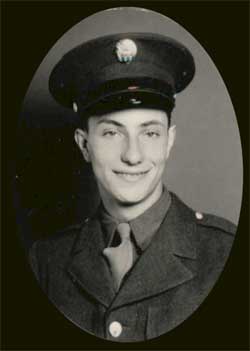
I
drove onto LST 282 in Italy with two soldiers from my unit, John Stasko
from Wilkes-Barre Pennsylvania and a soldier by the name of Reading.
The three of us were from Pennsylvania. If I remember correctly Reading
was from Reading. Thank God we all got off alive. The purpose of
the three of us was to work with the Battle Wagon and Cruisers off shore.
We were to communicate with "Charlie William", or Morse Code, which was
Morse
Code, BY KEY. Often my voice couldn't be heard because of noise
or German interference so the guys on the other end would say, "Amos, switch
to CW or Charlie William" so I would use the Morse Code key strapped on
my leg to tap out the messages in Morse Code which got thru when voices
couldn't. I had to learn Morse Code on the job.
We were from the 36I saw that there were too many men getting into the lifeboats and they
were sinking; so I stayed away from them and decided to save myself, just
common sense to stay away from those lifeboats. I had gone over the
side on the port side of the ship facing the Mediterranean sea and in the
darkness was mistakenly swimming away from shore.
I did not go but a short distance and there standing
directly in front of me was a man in a purple robe holding his arm and
hand down to me. I could not go in that direction no more.
His spirit took control of me, turned me in another direction as I had
been going out to sea. I began going toward the shore staying in
a vertical position and was drifting along with this burning, exploding
LST towards land. . I went several hundred yards when I came upon
a rock protruding out of water. I stopped there for a moment and
very shortly the sailor came after and said “come on, you can reach bottom,”
but there was none. I came back up again, went for shore and I made
it thanks to that man who I knew was one called “Jesus the Almighty of
this universe. ”
When I made it to shore I
found a barn and pulled hay over myself to try to get to sleep and I don't
know how I ever did it, but I did. I had built a hollow
nest out of hay bales up in the loft and then laid down inside
this box and covered up that depression with another bale "so that no one
could see me if they came up there. " I may have been a country boy
but I knew enough not to be on the barn floor! Later I was in Kufstein,
Austria, and present when Hermann Goering, the Commander of Luftwaffe,
surrendered and I was told to drive Goering's car and did so for a week.
I don't really remember what kind of car it was except that the word meant
"horse". (1) I don't believe it was a "Mercedes" as some other accounts
have reported.
Goering was moved out by a Cpt. Lily of our 36th in a Cub L-5
and Goering was such a large man that the two front wheels of the plane
went between branches of the trees at take-off from a hay field.
|
One of my buddies took this
photograph 2 weeks after the bombing. I had since moved on but my buddy
gave me this shot of 282 pulled up to shore. On the back of the photo I
had written: "LST 282 struck by a German
radio-guided thrust propelled, winged bomb. Aug. 15, 1044. I Amos R. Wolfgong
was on it at that time. " Photo
taken by MORRIS LEVINE, a radioman in my unit .
|
|
Click for larger view
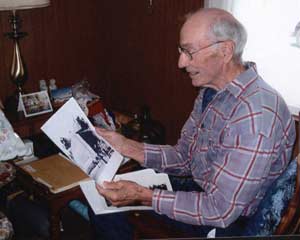
2005, looking at print-out of Web site. After
the attack an Army soldier took over the anti-aircraft gun (at top of photo)
and I thought it unusual for Army personnel to be able to use Naval equipment.
|
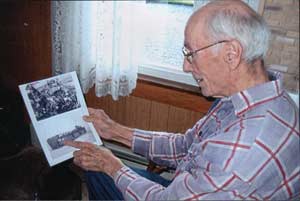
I'm pointing at the first "2" in
"282" on the bow where the hammock was hanging down --the hammock that
I slid down to get into the sea when I "jumped ship. "
|
Amos doesn't have
a computer but you can write to him at:
Amos Wolfgong
Box 262
508 Heathville Road
Summerville, PA
15864
or alternatively
email his cousin on wordchef<at>alltel.net who will gladly pass on all
correspondence. Amos is very keen to hear from his shipmates and other
interested parties.
NOTE:
Amos not only successfully survived the bombing and his subsequent "swim"
followed by a night in a haymow, and even though blown 50 feet across a
deck, he miraculously sustained only a skinned leg from the ordeal. Several
days after the bombing, though, he was "laid low in a cot for a week" from
malaria which he figures he had contracted during his year in Italy prior
to his being on LST 282. While his physical ills were minor from the bombing,
the emotional and mental toll of horrific nightmarish memories have been
61 years with him -- as with so many Veterans!
Notes
1) Possibly a Horch. In the late 1930s Horch built a special roadster
for Hermann Goering, but Goering chose a Mercedes 540K with bullet-proof
doors and windows instead. Horch built another four of these beauties.
It's quite possible that it was one of these cars.
|
|
|
Landingship.com © 2005-2025 Site by Dropbears


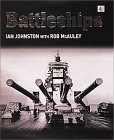
 I
drove onto LST 282 in Italy with two soldiers from my unit, John Stasko
from Wilkes-Barre Pennsylvania and a soldier by the name of Reading.
The three of us were from Pennsylvania. If I remember correctly Reading
was from Reading. Thank God we all got off alive. The purpose of
the three of us was to work with the Battle Wagon and Cruisers off shore.
We were to communicate with "Charlie William", or Morse Code, which was
Morse
Code, BY KEY. Often my voice couldn't be heard because of noise
or German interference so the guys on the other end would say, "Amos, switch
to CW or Charlie William" so I would use the Morse Code key strapped on
my leg to tap out the messages in Morse Code which got thru when voices
couldn't. I had to learn Morse Code on the job.
I
drove onto LST 282 in Italy with two soldiers from my unit, John Stasko
from Wilkes-Barre Pennsylvania and a soldier by the name of Reading.
The three of us were from Pennsylvania. If I remember correctly Reading
was from Reading. Thank God we all got off alive. The purpose of
the three of us was to work with the Battle Wagon and Cruisers off shore.
We were to communicate with "Charlie William", or Morse Code, which was
Morse
Code, BY KEY. Often my voice couldn't be heard because of noise
or German interference so the guys on the other end would say, "Amos, switch
to CW or Charlie William" so I would use the Morse Code key strapped on
my leg to tap out the messages in Morse Code which got thru when voices
couldn't. I had to learn Morse Code on the job. 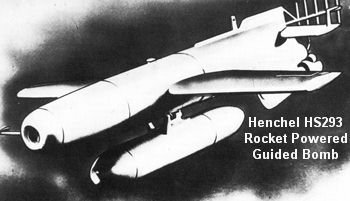 By
that time the other one was coming full speed at us and it was but thirty
feet to my right and down below me as I was looking down on it. I
saw it had a rocket approximately four feet long mounted on the vertical
stabilizer. It waved on its horizontal axis when approaching within
six feet of the 282. Even though I was close and watching, I never
remember seeing it explode. When the bomb exploded it seemed to have
destroyed a part of my brain, that it's gone forever. . . that particular
section of time during the blast was forever lost to me. I awoke a
long time after that and quite a distance from where I was at that time.
The ship had just begun to move toward the shore when it hit. When
I finally woke up, lying under a 4-wheel 40mm anti-aircraft gun,
the fire was raging like a giant forge and being loaded with gun powder
and ammo for the 155mm "Long Tom" gun, explosions and pieces of
the ship were flying.
After the JU88 struck the LST 282 he flew back and
forth over the landing area, dropping anti-personnel bombs on the troops.
By
that time the other one was coming full speed at us and it was but thirty
feet to my right and down below me as I was looking down on it. I
saw it had a rocket approximately four feet long mounted on the vertical
stabilizer. It waved on its horizontal axis when approaching within
six feet of the 282. Even though I was close and watching, I never
remember seeing it explode. When the bomb exploded it seemed to have
destroyed a part of my brain, that it's gone forever. . . that particular
section of time during the blast was forever lost to me. I awoke a
long time after that and quite a distance from where I was at that time.
The ship had just begun to move toward the shore when it hit. When
I finally woke up, lying under a 4-wheel 40mm anti-aircraft gun,
the fire was raging like a giant forge and being loaded with gun powder
and ammo for the 155mm "Long Tom" gun, explosions and pieces of
the ship were flying.
After the JU88 struck the LST 282 he flew back and
forth over the landing area, dropping anti-personnel bombs on the troops.
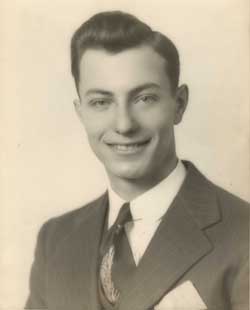 So
I laid down behind the anchor post, but soon a sailor dropped the anchor
so I had to move away. He hurried and stripped down and said to me
“come here to the side, there is a hammock hanging over the side, you can
go part way down it. ” I started down and so did the sailor
in just his skivvies who slid down that hammock so fast that he straddled
my neck which really propelled me non-stop into the water. Maybe
the sailor didn't even see me in the darkness. We went down, down,
down. I did not know how to swim and I was dressed in all wool OD
(olive drab) clothing, wool jacket, combat boots, gas mask, a heavy life
belt which the threaded end caps had stripped and filled with water.
I moved my arms and hands like someone who swims but I was in a vertical
position at all times and was moving.
So
I laid down behind the anchor post, but soon a sailor dropped the anchor
so I had to move away. He hurried and stripped down and said to me
“come here to the side, there is a hammock hanging over the side, you can
go part way down it. ” I started down and so did the sailor
in just his skivvies who slid down that hammock so fast that he straddled
my neck which really propelled me non-stop into the water. Maybe
the sailor didn't even see me in the darkness. We went down, down,
down. I did not know how to swim and I was dressed in all wool OD
(olive drab) clothing, wool jacket, combat boots, gas mask, a heavy life
belt which the threaded end caps had stripped and filled with water.
I moved my arms and hands like someone who swims but I was in a vertical
position at all times and was moving.


